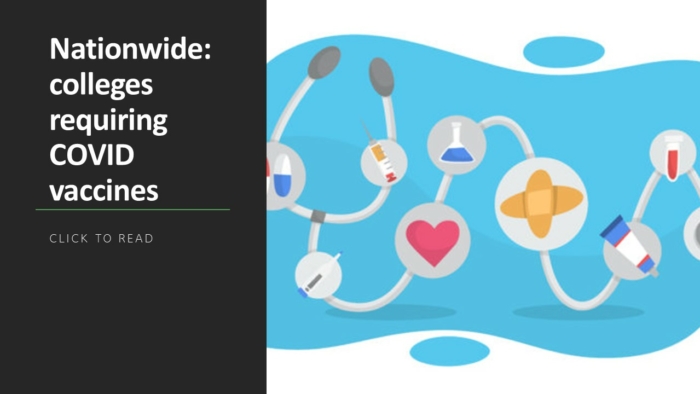Less than 35% of Americans over the age of 5 have received COVID-19 booster doses, according to data from the Centers for Disease Control and Prevention. The percentage among traditional college-age students is even lower.
Despite consistent guidance from the CDC and public health officials that vaccine boosters do prevent more severe outcomes from the disease and its variants, interest has been low because few individuals between ages 17 and 24 have experienced hospitalizations or deaths. Some colleges and universities that required vaccines from the start have even abandoned mandates on boosters or haven’t adopted them. But is that ambivalence about to change?
On Thursday, the CDC gave approval to what could be one of the biggest breakthroughs in COVID vaccine developments since December 2020, greenlighting a potentially more effective bivalent booster that targets both the original strain of COVID and the omicron subvariants, BA.4 and BA.5. Officials are hoping this shot, unlike the others, will offer much more protection than the originals, though trials have not yet been conducted on humans.
Millions of those Pfizer boosters are set to be available in pharmacies nationwide by Tuesday, with Moderna to follow shortly thereafter. Anyone 12 and over can get them, and health officials are again urging populations to roll up their sleeves, if not to protect themselves then to protect others who are in potentially vulnerable populations.
“If you are eligible, there is no bad time to get your Covid-19 booster, and I strongly encourage you to receive it,” Dr. Rochelle Walensky, director of the CDC, said in a statement.
More from UB: Monkeypox, COVID and masks: Most colleges tell students, it’s on you this fall
That message has been echoed by most college leaders throughout the pandemic, although many of their institutions have relaxed requirements and protocols since the start of the year. That seemed a safe strategy, but COVID is still lingering, punctuated by the developing situation at the University of Illinois, which is experiencing one of its largest outbreaks of COVID since the pandemic began. In the seven days leading up to Sept. 2, it registered a whopping 1,194 cases at a more than 20% positivity rate, easily the highest in more than two years. Only 1,100 tests are being conducted now of undergrads on its campuses, a massive decline from the 10,000 or so it had in the fall two years ago.
The university, once staunch on its mandates, is not requiring masks or boosters, though it did mandate the initial vaccines and got 92% compliance. But with this outbreak and with the new bivalent vaccines, will Illinois adjust its policies, or will it follow the lead of Gov. J.B. Pritzker, who has said colleges and universities no longer need to require them? Expect to hear more in the coming days on updated guidance from Illinois and other institutions, as well as the availability of boosters on campuses.
Isolated incidents or not?
Over the past month, many universities not only eliminated masking requirements for the fall but also told students who test positive for COVID to isolate in their residence halls, a popular decision from 2021-22 that saves precious housing space and puts less strain on colleges to care for them. But one institution, West Virginia University, surprised its students this week by telling those who test positive they must enter separate isolation housing.
“We know this is difficult news. However, please be assured the WVU family is here to support you through this time,” the university said in a release to students. “We ask you to stay calm. As a member of the community, it is critical that you take necessary measures to keep everyone safe.”
The cost of noncompliance at West Virginia includes the possibility of being removed from classes and/or housing and even being expelled. Those who continue to be symptomatic after six days must remain in isolation until they are released by the university. Even after the release, students must wear masks for five days. The university, which does not require vaccines but has seen more than 80% of its students get doses (20% more than the rest of the state), did exceptionally well keeping positive cases down throughout the fall of 2021 and spring of 2022.
Though positive cases have fallen since last winter, there also has been far less testing being conducted. And 15 states are showing positivity rates at 20% or more, including Missouri at 33% and South Dakota at 29%. Only seven states and Washington D.C. have positivity rates lower than 10%.
As institutions navigate the start to the fall and the potential for COVID cases to rise, the American College Health Association has recommended looking at policies related to boosters and leaning on guidance from the CDC:
“At this point in the pandemic, the primary COVID-19 vaccine series should be routinely recommended and made available on campus, if possible,” the ACHA wrote in its August update. “Boosters should also be made available on campus for all eligible students, faculty, and staff. Because boosters are necessary to maintain sufficient immunity, healthcare providers must be well versed in the booster eligibility categories to make appropriate vaccine recommendations to include timing, dosage, contraindications, and risks. Ideally, campus community members should be up to date on COVID-19 vaccines and boosters. If the campus does not have the resources to provide immunizations and boosters, arrangements should be made with local health resources to ensure easy access for the campus community.”







